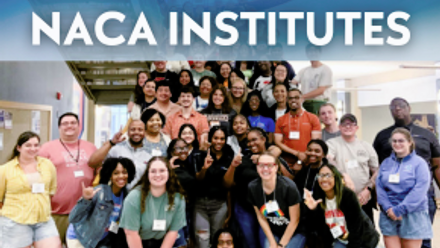Pulse Check: What is your Campus’ “Social Connection” Score?
Data is important, right?
It gives us a snapshot of how something is going and potentially guides us towards the actions we can take to improve it. However, it's sometimes tough to get data for certain things. Some things are clear-cut, and other things can be more subjective.
How many students showed up to a recent event? Is campus enrollment rising or falling? These are pretty simple. But then we look at more complex things like how "socially connected" do students feel on campus?
While certain data can be easily measured, the data behind social connection is something that rarely has a number associated with it. As a result, many colleges find themselves unsure of their "social connection score", leading to speculation or best-guess estimates."
Have you ever tried to measure the level of social connection on your campus? What steps would you take to achieve that?
Social connection can be defined as the experience of feeling close and connected to others. It involves feeling loved, cared for, and valued, and it is the foundation of interpersonal relationships. Without it, loneliness can creep in and social disconnection can happen among students, leading to feelings of depression, anxiety or social isolation. In fact, the effects of social disconnection can even go beyond mental health, impacting one’s physical health, their friend group or even their likelihood of finishing their degree.
While this all sounds subjective and fluid, there are actually ways to determine social connection on campus, and from that, implement practices to improve it.
However, this first starts with a pulse.
In the medical world, a pulse is essential. When a doctor examines a patient, they check the pulse, which indicates overall health. If there is an issue, the doctor gives a suggestion to the patient, and schedules the follow up to make sure the suggested solution works. The same is equally important when it comes to the pulse of social connection from students on campus.
Whether it is for the people at your event, or if it is for the student body as a whole, a pulse is a great way to understand the current state of a campus and provide a baseline to measure against in the future. The best way for getting a pulse of social connection at an event or at the campus level would be through a specific social connection survey. This survey is a little different than other surveys though. This one takes a little more thought and goes beyond a simple transaction of information.
5 Things to Consider Before Sending out a Survey
- Understanding the “Why?” of a Survey
This question is for both the surveyor and respondent of the survey. The “why” for the surveyor is important because without understanding the need, the sender will have a hard time positioning why they should spend a few minutes filling this out. The surveyor needs to be passionate about the pulse they are taking and be able to answer any questions the responder asks. When both parties understand the value of the survey, more people take it, and more impact can be made across responders. Educating students on what social connection is and why it's important can also go a long way. When students know the value of social connection and know that they can speak freely to improve their surroundings, they will be more likely to contribute to the bigger picture. - Survey Respondents
The person taking the survey and sample size are both important to understanding the whole. There is no perfect number for this, and having a majority isn't always feasible, but a good sample size is at least 5-10%.The best place to start when it comes to getting data, is getting as many people you can to record and ensure that the mix of people represents what you intend for the final results to imply. - The Confidentiality of a Respondent
Surveys need to be anonymous, and this is because students are more likely to answer truthfully and openly when they know it's not going to be tied back to them. Instead of asking for their name or email address, find a way to distribute the survey to as many people as possible and make sure you let them know it's not tied back to them. When it comes to discovering the social connection of a group, ask for the group or campus name, and then potentially narrow that down in the future. - Survey Length and Depth
Surveys need to be short, but they can also be thorough. It’s tough because you want to get the best info out of your group that is answering, but you don't want them to leave before they submit the results. A lot of forms are either too long or too short because the party sending them out hasn't simplified the form or because they were afraid they would lose the number of responses. A form should take less than 3 minutes to fill out (including instructions) and should be around 15-20 questions. Bonus tip: by creating great questions, you can see what questions score the lowest, and prioritize your efforts here first. - Providing Immediate Feedback
Collecting data from a survey has always been the obvious objective but unfortunately, a lot of people stop there with surveys. Traditionally these have been a tool to collect data, but a lot of surveys are now intuitive enough to give results immediately based on the responders answers and give solutions that accompany these results. Not only do you gather info to understand the pulse, but you give them the option to improve things the second they uncover new information about their levels of social connection.
The Three Types of Surveys
- The Soco Survey - This is a free survey we've used at schools to help them understand their social connection on campus or even with small segments of campus activities. It takes two minutes, records all the data for the surveyor and gives the students a snapshot of their social connection score, including tools to accompany it.
- Custom, Online Surveys - Google Forms is customizable, free and good when needing quick feedback. It wont give results immediately, but it does capture great info that can be shared later. You can also consider building something out in Typeform or SurveyMonkey depending on your needs.
- Traditional Printed Methods - while printed surveys may feel a little antiquated, these are valuable for getting feedback in the moment at events or when handing things out on campus. A printed form can be customized, and it can guide the responder on adding up their answers and can show them results with a little bit of manual work.
The way a survey is distributed is also very important when it comes to getting results for your surveys. One effective approach is to leverage existing communication channels on campus, such as email newsletters, student forums, or social media platforms. By reaching out through channels already familiar to students, you can maximize participation and engagement. Additionally, consider working with student admissions or other campus organizations to amplify the survey's reach and encourage participation across diverse student groups. Education and incentives, such as raffles or rewards for survey completion, can further motivate students to participate and provide honest feedback as well.
Social connection surveys serve as incredible tools for understanding the well-being of students and creating a sense of community on campus. By assessing the level of social connection, institutions can identify areas for improvement and implement targeted interventions to enhance student support systems. Plus, when a student self-identifies areas of improvement, they can be more cognizant of where to invest time in their own social connection journey. Furthermore, emphasizing the importance of social connection in academic success and personal well-being reinforces the significance of focusing on social connection. By actively involving students in the process and giving them direction based on their responses, institutions can guide and cultivate a culture of social connection on campus, ultimately enriching the campus experience for all.





